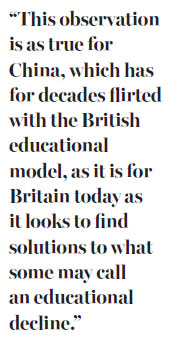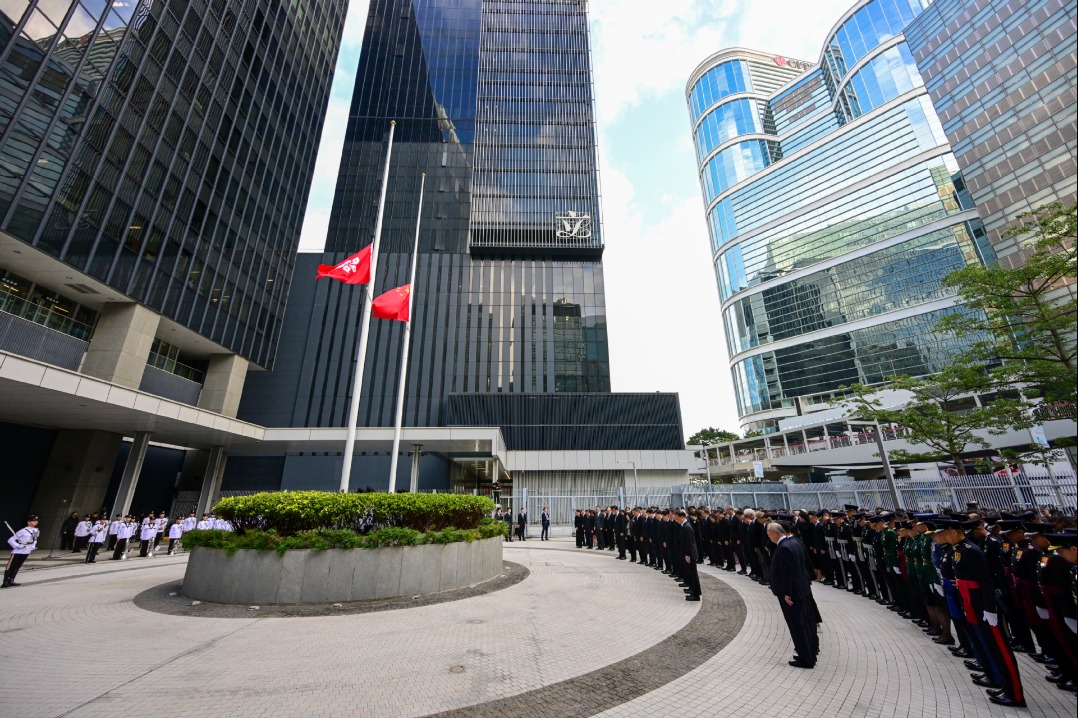Studying where and how worldviews can meet

China and Britain should learn from each other, but we need to be clear about the purpose to avoid blind alleys
The experiment at Bohunt School illustrated what those engaged in the study of comparative education have long believed: that it is not possible, or even desirable, to transplant into one's own educational system the features of another system rooted strongly in its own cultural context.
Michael Sadler, the head of the Office of Special Inquiries and Reports in London from 1895 to 1903, made an early and acute observation.
He said: "We cannot wander at pleasure among the educational systems of the world, like a child strolling through a garden, and pick of a flower from one bush and some leaves from another, and then expect that if we stick what we have gathered into the soil at home, we shall have a living plant."
Sadler argued that a national system of education is a living thing that embodies "the outcome of forgotten struggles and difficulties and of battles long ago", and has in it "the secret of workings of national life".
This observation is as true for China, which has for decades flirted with the British educational model, as it is for Britain today as it looks to find solutions to what some may call an educational decline.
This is not to say China and Britain cannot or should not learn from each other. What is important is to be clear about the purpose. In this, there are blind alleys and promising avenues.

In these globally comparative and competitive times, in which a direct relationship between educational achievement and economic success is assumed, it is not unusual for those who shape educational policy to seek to model their own systems on those of countries that perform academically better on international comparative assessments, and who show good prospects for sustained economic growth.
For much of the time, however, this is a blind alley. As we have seen in the Bohunt experiment, lengthening the school day or changing the culture of pedagogy from exploration and enquiry to memorizing and applying are policy options not likely to transplant well.
More promising is a tutored and selective approach. China, too, has aspirations. It seeks to carve out and cement its place as a global leader, politically, economically and culturally. So the country looks to maximize what it can learn from elsewhere, but it is perhaps a more skilful, more careful educational policy surgeon, better able to graft the cells of how others know and do into parts, but not the whole, of its own system.
While it was natural in the past for England to export ways of knowing and doing, perhaps buoyed by the dictums of 19th century educational explorers such as former US president John Quincy Adams (1767-1848), who advised "the travelers" to "remember that he is called not to import the principles or habits of foreign nations into his own, but to export to those less-favored countries the principles and practices he has learned at home". China was and remains a master of the art of acceptance and rejection.
Perhaps in a more quiet way then, but now more knowledgeable and confident about the strengths of its own educational DNA, it is more purposeful in what it seeks to absorb. For China, it is less about seeking to copy uncritically what is done elsewhere, rather to learn from and understand it.
I participated in the 10th International Forum for School Principals in November 2014 in Zhenjiang, Jiangsu province. While there was a great deal of interest in theories and techniques of school management in Britain, Australia, Canada and the United States, China was also keen to demonstrate its own cultural forms of school leadership.
The real challenge, it seems, is not what and how much we can learn from each other to improve our own educational systems; it is how we learn together to face a world that is increasingly interconnected and at the same time more diverse and plural, and how we learn to face collectively the unknown challenges of tomorrow - food security and poverty, climate change, and global terrorism.
It is not about learning from others to improve our own, but learning together in an open-minded way to forge a new way of knowing and doing.
The challenge then is to learn not only from different worldviews, but to learn at the confluence of where worldviews meet.
The author is reader in comparative education and a professorial fellow of St. Antony's College, University of Oxford. The views do not necessarily reflect those of China Daily.
(China Daily European Weekly 05/20/2016 page9)
Today's Top News
- Takaichi must stop rubbing salt in wounds, retract Taiwan remarks
- Millions vie for civil service jobs
- Chinese landmark trade corridor handles over 5m TEUs
- China holds first national civil service exam since raising eligibility age cap
- Xi's article on CPC self-reform to be published
- Xi stresses improving long-term mechanisms for cyberspace governance






























